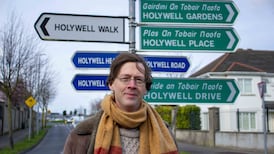Senior counsel Maurice Gaffney, the State's oldest active barrister, has died. He was still active at the Bar in his 100th year.
In part to mark his 100th birthday and his continued involvement in the Bar, Gaffney was to make a legal application in the Supreme Court on October 11th before Chief Justice Susan Denham, with the media invited to attend to record the occasion. However, the event was cancelled after he became unwell.
Gaffney was well-known for his enthusiasm, for the tradition of collegiality in the Law Library and for his friendliness and approachability.
“He was unfailingly kind to junior colleagues in the Law Library and was always available with advice and the benefit of his wisdom,” said Bar Council chairman Paul McGarry SC.
Born in Co Meath, his father was a member of the Royal Irish Constabulary, and because of that the family moved frequently. The year after the Easter Rising, they moved to Dublin, first to a house on Aughrim Street in Stoneybatter and then to Upper Gardiner Street, where, Gaffney told The Irish Times in an interview earlier this year, they had "a fine house".
In the 1940s, the family moved to Finglas, then at the edge of the city. Gaffney studied for an arts degree, joined the Jesuits, left after he got ill and became a teacher.
Enthusiasm
After a five-year stint in Glenstal Abbey School, Co Limerick, he returned to Dublin to be with his father, who was ill, and took a job with a school on James Street. He also began studying law and was called to the Bar in 1954. At the time, there were about 250 barristers in the State, of whom some 50 were not practising. There were five women barristers (one of whom, Leonie Lehane, he would later marry).
An new unit in the Bar Council’s building on Church Street, Dublin, for continuing professional development, has been named the Gaffney Room, a fact that was made known to him this autumn.
In his early years, Gaffney did work on the eastern circuit, taking prosecution cases in Co Kildare and elsewhere. From the start he liked the work and would become a senior counsel in 1970.
His enthusiasm for his profession remained strong over the following decades. He worked in both civil and criminal law and could get excited about the wonders of property law, something that many of his colleagues might regard as the more tedious end of their occupation.
He was considered to be particularly knowledgable in the area of railway law.
Gaffney was also active in employment law and for seven years was chairman of the Employment Appeals Tribunal, having been appointed in November 1978 by the then Fianna Fáil minister for labour Gene Fitzgerald.
Forceful symbol
Among the major cases he was involved with over the course of his long career was that of the
Director of Public Prosecutions v
O’Shea
, where the Supreme Court was asked to rule on whether a jury’s verdict could be appealed. Gaffney argued that it could and the court came down in favour of the argument made.
In the 1990s he was involved in the case in which former hotelier and Fianna Fáil politician Des Hanafin tried unsuccessfully to challenge the result of the divorce referendum.
As he continued to work long after his contemporaries had retired, he became a forceful symbol for the tradition of collegiality that he felt was stronger in his chosen profession than it was in most others.
In the interview with The Irish Times in February, he said he worried during the Celtic Tiger years that the money being made by some members of the profession was affecting the solidarity that he thought was such a valuable aspect of the Law Library.
In 2013, Attorney General Máire Whelan told an RTÉ TV feature on Gaffney that she valued his counsel, which she sought on behalf of the State. Younger barristers told the programme of how approachable Gaffney was and how willing he was to give them advice.
The following year, when he was being presented with a Lifetime Achievement Award at the Irish Law Awards, he was asked by Miriam O’Callaghan for the secret of his longevity. “The company of young people,” he said.
It was a point he repeated in his February interview, where he said the colleagues he worked with in the Law Library ranged from those in their 20s to those in their 80s. “Age doesn’t come into it, and so I don’t age.”
He is survived by his wife Leonie, his children John and Patricia, his grandchildren Stephen, Jonny and Leonie, John’s partner Francesco, his son-in-law, Stephen, and wider family.










